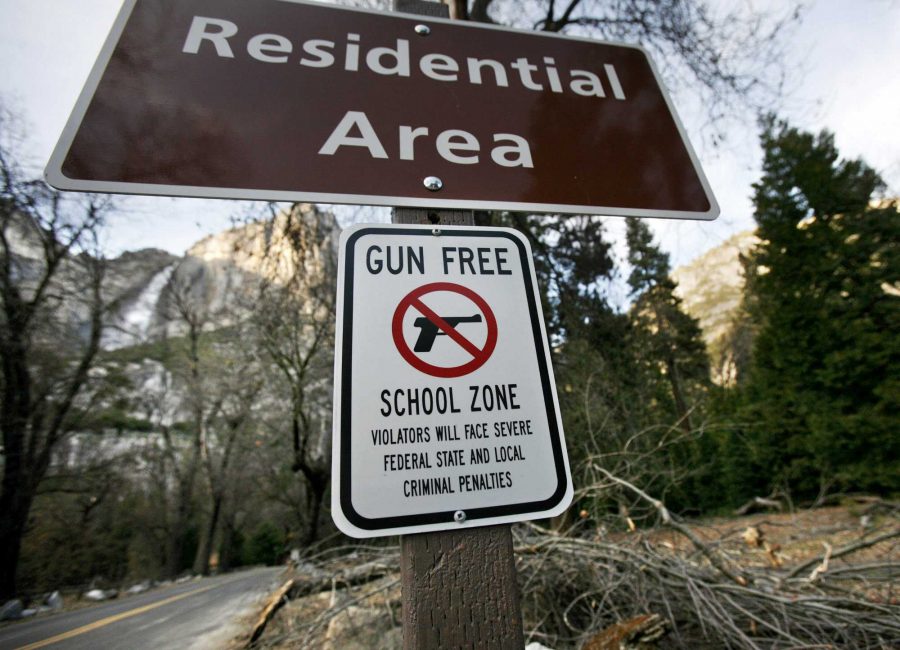It seems like every other week, a shooter walks into a public meeting space and opens fire.
Just this Friday, Northern Arizona University and Texas Southern University had shootings that claimed the lives of one student from each university. The week before, in Roseburg, Oregon, Umpqua Community College lost nine of its students in a mass shooting.
In response to the unsettling frequency of such events, politicians are thinking of ways to mitigate these atrocities. Left-leaning politicians, like President Obama, suggest tightening gun regulations — their logic being, less guns will bring less mass shootings.
Yet, one thing is clear about the recent mass shootings — the victims had no way to defend themselves.
Rather than disarming Americans, we should abolish gun-free zones that make Americans unable to defend themselves and others. We must allow responsible citizens who surpassed the current process of background checks to feel safe from deranged shooters who target defenseless people.
According to the Crime Prevention Resource Center, a staggering 92 percent of shootings happen in gun-free zones such as schools and churches. There is clear evidence from some of the most infamous shootings showing the shooters had targeted places free of armed guards and armed people.
Time and time again, we see places with higher gun regulations continue to have shootings and violent crime.
Take Chicago, for instance. You can’t even find a gun shop in Chicago because they’ve all been outlawed. Yet, despite the extreme gun laws in Chicago, nearly 2,400 people have been shot this year.
Similar to Chicago is Australia. In response to a 1996 mass shooting in Tasmania, where Martin Bryant killed 35 people, the Australian government bought nearly one million guns back from armed Australian citizens in a mandatory gun buy-back program. One would think that with no guns, Australia would see a reduction in crime — yet, it saw the contrary.
After the gun ban, serious crimes in Australia skyrocketed. Manslaughter, sexual assault, kidnapping, armed robbery and unarmed robbery peaked following the ban, according to the Australian government’s data — all of which could have been prevented if the victims had guns to defend themselves.
Plus, despite the ban, armed robbery constitutes 27 percent of crimes being committed in Australia, suggesting criminals have been able to acquire guns regardless.
Australia is an example of what happens when politicians take guns from law-abiding citizens. Albeit extreme, the Australian mass gun buyback demonstrates a populace defenseless against crime.
Take the recent Charleston, South Carolina, shooting when Dylann Roof killed nine people at the Emmanuel Church this June, for example.
According to an Associated Press article from June 19, Christon Scriven — who claimed to be friends with Roof — said that the shooter had expressed that he had originally planned to attack College of Charleston, but, upon learning of the security, he instead chose a church.
“I don’t think the church was his primary target because he told us he was going for the school,” Scriven told the Associated Press. “But I think he couldn’t get into the school because of the security … so I think he just settled for the church.”
Similarly, Elliot Rodger — the man who fatally shot three people in Santa Barbara, California, last year — said in a 141-page manifesto, that he ruled out certain targets because he was worried someone with a gun would end his killing spree prematurely, according to the The Las Vegas Review-Journal.
We see what happens when guns are banned completely. People are left defenseless, unable to protect themselves and their families. And criminals — despite the illegality of owning a gun or government regulations designed to make getting a gun more difficult —were still able to acquire them, like in the “gun-free” country of Australia.
Criminals — by definition — defy the law. They will acquire the means to commit crimes no matter what. So what happens when we arm law-abiding citizens?
After Michigan passed a Right to Carry law in 2001 — which allows those with a concealed carry permit to openly carry their firearm — the murder rate fell by four percent. Since Texas instituted its own Right to Carry law in 1996, the murder rate dropped an astounding 30 percent, according to the National Center for Injury Prevention and Control.
Not only are the statistics proving that less regulations along with Right to Carry laws contribute to less crime, but there is a feeling of safety in the presence of a responsible gun owner.
We rely on police, security guards or someone with a gun to rise to action in the event of anything from a robbery to a shooting.
Many times it takes police too long to respond to mass shooting situations, given that they are typically short-lasting and unexpected. According to a 2014 report from the FBI, 66.9 percent of mass shootings had ended before police even arrived at the scene and could engage the shooter.
“The only thing to stop a bad guy with a gun is a good guy with a gun,” said Wayne LaPierre, executive vice president of the National Rifle Association, in a public statement in response to the Sandy Hook shootings.
We can’t deny we live in a dangerous world. There are criminals among us, and we must be able to protect ourselves and those around us in a life-threatening situation. Although we can’t stop mass shootings from happening, we can mitigate the issue by abolishing gun-free zones, allowing responsible Americans to protect themselves and their families.
Too many tragic events prove that gun-free zones and less guns are not the answer — they only make victims out of defenseless people.
Marlo Safi primarily writes about public policy and politics for The Pitt News.
Write to Marlo at [email protected]



